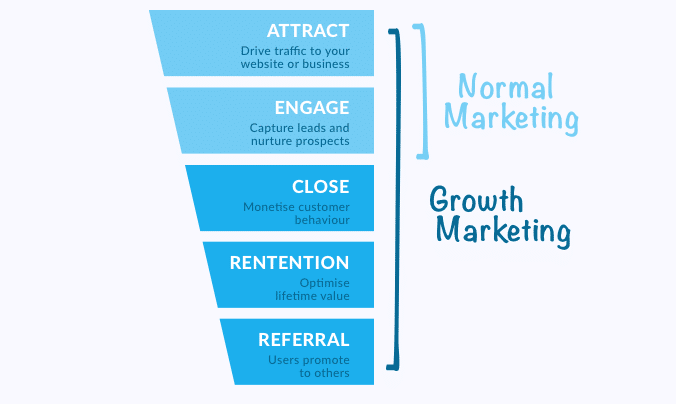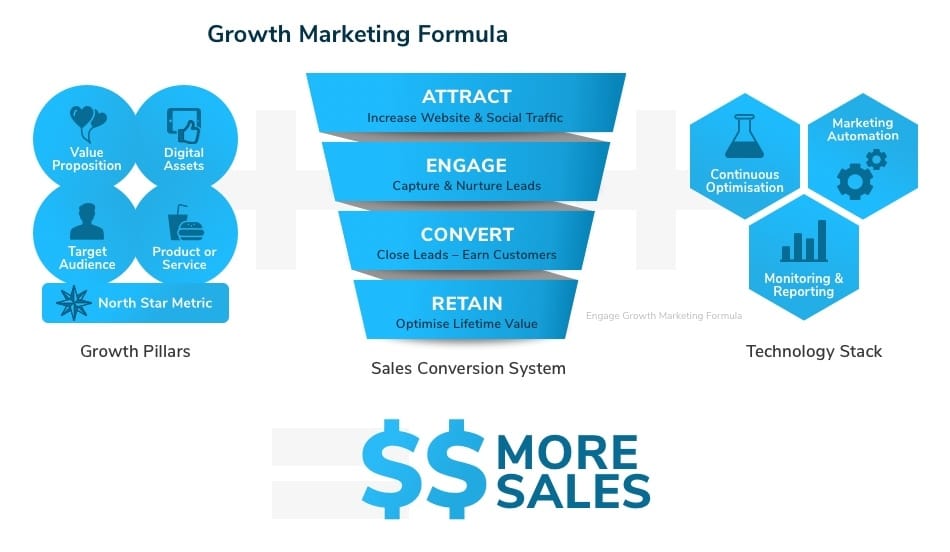Growing a business isn’t easy. The fortunate thing is that there’s plenty of tactics you can experiment with. In this post, I overview Growth Marketing and cover 7 growth ideas any business could be boosting profits with.
Growth Marketing vs Normal Marketing
You guessed it; Growth Marketing is all about growing your business. But surely so is normal marketing, right?
It’s easy to get caught up in the buzzwords and it doesn’t help when there is no accredited definition of either of those terms. Like the fashion industry, this year’s flares are next year’s retro.
To me, if there is such a thing as “normal” marketing, it’s about establishing a product that people want (vs traditional marketing, where we made people want the product).
It’s about defining your ideal customers and clarifying a value proposition that’s true to your product and culture while providing a unique and compelling reason for those ideal customers to purchase.
Then its implementing tactics that guide your prospects and customers on the journey they want to take.
Long term growth only comes about when you have built a strong marketing foundation and strategy first.

The growth methodology however takes over from here.
Growth marketing is the process of discovering which channels allow you to attract and convert the greater number of customers at the highest amount of profit.
It’s about constant experimentation and optimisation, even when you think you have the formula right. You’re using the process to find, test and analyse better ways to profitably attract and retain additional clients.
But you can’t have growth without the normal marketing – you need to build and continually upgrade your marketing foundation while optimising your growth system on top of an ever-expanding business.
Growth Hacking Grown Up
Growth marketing is often described as “growth hacking grown up”, in which marketers use data and agility to scale revenue through reasoned and scalable tactics.
It’s like the best of all worlds; an amalgamation of growth hacking strategies and traditional marketing methods.
The growth marketing principles work equally well for start-ups as they do corporates.
In our growth marketing services page we cover how it’s a process of constant experimentation, refinement and agility.
The true challenge is ensuring that growth is always trending in the right direction — meaning optimal profitability — and that we’re not running experiments for the sack of it.
Before we cover just a few growth marketing ideas to try, let’s look at some key Growth Pillars…
Build strong Growth Pillars
Growth marketing isn’t about jumping in the deep end and trying every radical marketing idea that comes along – that’s growth hacking.

Sustainable results will only be achieved if our growth pillars are strong and on point.
Seth Godin amplifies the message that the journey has to start with an amazing product and that’s why one first pillar is product development.
You can maintain your brand the old way (pushing it on people with advertising), but the only route to healthy growth is a remarkable product.
Understanding what makes your product desirable, of course is equally important.
We need to be able to communicate the brand’s value proposition – your product or service might be great but if it can’t be understood then it will remain invisible.
Another vital pillar is identifying your market through buyer personas.
Knowing about a prospect’s problems and what started them on the journey for a particular solution, can shape the type of message you deliver at each stage of your sales funnel.
Don’t try and make a product for everybody, because that is a product for nobody. As we repeatedly say at Grand, “Narrow the focus to build the brand.”
The way you break through to the mainstream is to target a niche instead of an entire market.
Fitting in can only lead to average results or failure. Standing out is your only option.
This doesn’t mean you have to be radical necessarily – but it does mean standing for something unique and desirable within your market. If we push for the edges we may end up somewhere unique and profitable.
If your proposition is right, early adopters will ‘sneeze’ and larger audiences may follow.
Optimise the channels your audience frequents
When you truly know your audience, you can narrow down those preferred communication platforms and social channels.
You can also determine the best day and time to interact with them.
Study your website analytics, run an inexpensive SurveyMonkey survey, call even a handful of regular or first-time customers – do what you can to more fully understand your audience, their motivations and their channel habits.
That way you’ll know how to reach new customers and retain the existing ones.
Even when budgets aren’t limited, you want to ensure you have the resources to properly manage those best channels. If you don’t, your audience may think you aren’t paying attention.
Focus on Quantifiable results
You’ll never know how much you really grew from your marketing initiatives, if you don’t set measurements and track them.
Focus on targets that matter.
Maintaining a high conversion rate at the sake of all else is likely to be a fool’s goal if a certain channel provides a great deal of traffic at a far lower conversion but at an incredible cost per acquisition.
There are certain metrics that really matter:
- Profit: For most of us the ultimate goal is absolute profit
- Revenue: How much hard money does a particular marketing channel generate?
- ROI: How much do you make for what you spend?
- Conversions: How many website or store visitors from a specific channel actually make a purchase? Or check out softer conversions, like ‘viewed more than 3 pages on your site’ – at least you know they showed some interest in what you have.
- Average spend: What is the average sale per customer?
Just 4-6 top-level Key Performance Indicators can help make all your activity data understandable, relevant and useful.
Regularly Switch up Your Growth Marketing methods
If you do what you’ve always done, you get what you’ve always got.
The real potency of growth marketing is the willingness to experiment and optimise.
Aim to try a few new growth marketing initiatives each quarter. Consider giving one or two a few quarters to establish themselves, and switch others out so you can try new types of mediums or digital tools, such as:
- Experimenting with Exit intent pop ups for lead generation
- Live chat with chatbots helping with frequently asked questions
- Explainer videos as centrepieces on landing pages
- Change-up your abandoned cart emails ending with a stronger offer
- Schedule a radio promotion to draw in leads
- Show personalised content via geo-fencing
- Display advertising on highly targeted industry websites
Use A/B testing to continually trial new ideas or fine adjustments.
A/B testing (or split testing) is essentially an experiment where two or more variants of a tactic are used at random, and statistical analysis is used to determine which variation performs better for a given conversion goal.
Try Google Optimize for free. Optimize is natively integrated with Google Analytics, so you can quickly understand how your website can be improved.
Tools like Crazy Egg not only offer A/B tests but also other website optimisation tools like heat maps.
Enough about the setup let’s take a look at some Growth Marketing ideas you could put in motion this week…
Idea #1: Use FoMo to Create a Sense of Urgency
Sales funnel stage: CONVERSION
FoMo, the Fear of Missing out, is a very real phenomenon that affects the desirability of a product or person.
It’s characterised as feeling anxious that something exciting or interesting is happening elsewhere.
If a product is being used and loved by everyone (especially your friends), you feel drawn towards it, in case you “miss out”.
What might not have been appealing before all of a sudden is a must have – life cannot go on without it!
Use this psychological principle to your advantage by limiting access to your product or by raising anxiety by the fact that others are already experiencing your incredible offer.
Idea #2. Offer a trial so users can test your product
Sales funnel stage: CONVERSION
We all know how a product sample, test drive or a free trial of an app for 2 weeks can push us across the line.
It removes all barriers and lets us test something out in a real-life situation.
It could be the difference from buying a competitor’s product or yours.
Think how you might be able to use a “free trial” method with your product or service even if the application is not immediately obvious. Here’s some examples:
- Practice what you preach, right: Grand offers $1000 cash back as a way to get new qualifying customers to trial us.
- Hot Spring Spas provide a free private test soak.
- Vehicle companies practice “de-horsing” their customers – if they can get you out of your current car, you going to have to buy a new one.
- An accounting company could offer a free consultation.
- A personal loan company could offer free insurance for a limited time on a financed vehicle.
Remove all barriers – avoid asking for a credit card or even “login details”.
If a free-trial fails to convert, extend its length and inform the user via email.
Follow up with guides on how to get the most out of the product or service.
Idea #3: Set up a Welcome Series of emails
Sales funnel stage: RETENTION, REFERRAL
When a new user signs up, the next few weeks are crucial for to retain their loyalty.
Plenty of users will sign-up for your product and forgot about it in a week – how many forgotten apps do you have sitting on phone?
Your job at this stage is to remind the users that you exist, and that you can add ongoing value – particularly if they have just completed their first purchase from you.
One way to do this is with a welcome series of emails setup within your marketing automation software like SharpSpring or HubSpot. Use that series of emails sent over a two or three-week period to:
- Introduce new product features
- Provide details about warranties or after-sales services
- Share tips so users can get the most out of your product
- Introduce a special member of your team
- Cross-sell or upsell to related products
- Include a special offer to get the new customer back for their second purchase
- Ask for a Google review and rating
- Include a friend-get-friend promotion; where the customer and a friend both get rewarded following the friend’s purchase
Idea #4: Use Gamification to make things interesting
Sales funnel stage: ENGAGEMENT
Gamification refers to the process of making the user experience feel more game like.
It could be as simple as animating the display of 4 stages of an online application or as complex as an actual online engage to engage and interact with customers.
Here’s a good example we developed for MyFinance – as a user moves a slider to change the amount they are looking to borrow, the car image changes to reflect a model in that price range.

Gamification could take many forms and influence promotions, onboarding new customers, improving checkouts or providing rewards.
Idea #5: Turn your written content into images for social media
Sales funnel stage: ATTRACTION
Fact: images do better than text in social media.
Repurpose your strong written content into shareable images on your website and also share those images on Facebook, Instagram, Twitter and Pinterest.
From a business view point, turn the 7-point product setup checklist into an infographic.
Turn your research findings into statistical graphics
Find an appropriate image to go with a company quote and create a shareable image with Canva

Idea #6. Update your CTAs
Sales funnel stage: ATTRACTION
Your landing pages live or die based on the success of your Calls-to-Action.
It determines if people take your content and bounce out never to return, or if they take your valuable bait and engage further into your sales funnel.
Such a simple thing that could produce big results – check the copy you use on Call-to-Action buttons including social share CTAs.
- Use it to describe explicit instructions that you’d like your visitor to do next.
- Avoid vague and negative words like the overused default copy for buttons; “SUBMIT”
- Include simple verbs in your CTA to highlight the design action like “Go”, “Get”, “Start”, “Click”.
- Instead of the words ”share” or “Facebook” for a social media call-to-action, how about “Share this story” to tell readers exactly what the button does.
- A/B test options because a 1-5% (or much more) increase in conversions is worth it.
TIP: usually the best text comes from completing this sentence; “I want to ___________”.
For example, “I want to Send this Message”, “I want to Add to Cart”.

Idea #7: Offer users a No option in opt in forms
It seems counter-intuitive but the adding of an opt-in step has shown to increase conversions in some cases as much as 5-times!
Rather than abandon the call-to-action or pop up message, to signup or download your lead magnet, Yes/No opt-in forms actually increase conversion rates by making the opt-in choice more meaningful.
It supports the resolve to take up the offer while underscoring the result of a negative path.
When we’re bombarded with so many options to join, subscribe or download, it could create a positive tipping point that we respond with “oh why not, this time I will sign up”.

The result is more opt-ins.
Takeaways
With your growth pillars covered and a technology stack in place it’s time to get on with your strategies and tactics.
Under a growth marketing approach that means implementing a core of activity and then experimenting and testing tactics that look to optimise revenue and profits.
As the short list of ideas covered here suggest that’s about implementing a rolling sequence of tactics drawn from an idea backlog and selected because of their relevance, cost and business impact.
The methodology suggests that it’s not one thing that will win the battle but a continuous introduction of improvements on a weekly fortnightly or monthly basis.

